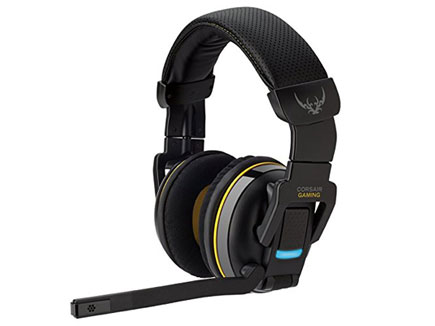Tom's Guide Verdict
The Corsair H2100 stands out for its superb sound quality, focus on comfort and helpful preset soundscapes.
Pros
- +
Comfortable design
- +
High wireless fidelity
- +
Great sound
- +
Helpful presets
Cons
- -
Shallow software
- -
Slight background hiss
Why you can trust Tom's Guide
Whether you have a living room setup or you just hate clutter, you shouldn't have to stand for a wired mouse, a wired keyboard or a wired controller. So why would you put up with a wired headset? Rather than letting your pets, your kids and yourself trip over a long cord, you should invest in a Corsair H2100 gaming headset ($95.99 on Amazon) instead. Among wireless headsets, the H2100 stands out for its superb audio quality, 7.1 surround-sound support, focus on comfort and helpful preset soundscapes. A few tweaks could have made the H2100 perfect, but as it stands, it's one of the best wireless headsets in its price range.
Design
First, the H2100 is enormous, measuring 9 x 3.5 x 9.5 inches. The headband and earcups are positively huge. If you need a travel-friendly headset, this is not it. Size aside, though, the peripheral is rather attractive, featuring a sleek, black design with tasteful hints of yellow.
MORE: Best Gaming Desktops
The H2100 feels solid, and includes both an adjustable headband and swiveling earcups. The over-the-ear earcups are, like the rest of the device, very large and covered with comfortable padding. A pivoting microphone on the left side rounds out the device.
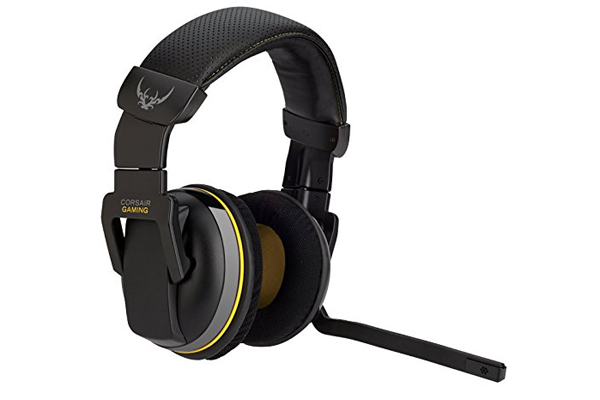
As the H2100 is wireless, the dongle design is also somewhat important. While the dongle itself is simply a small, unobtrusive USB stick, it also comes with a long-wired stand so that you can set it up at a visible, convenient location.
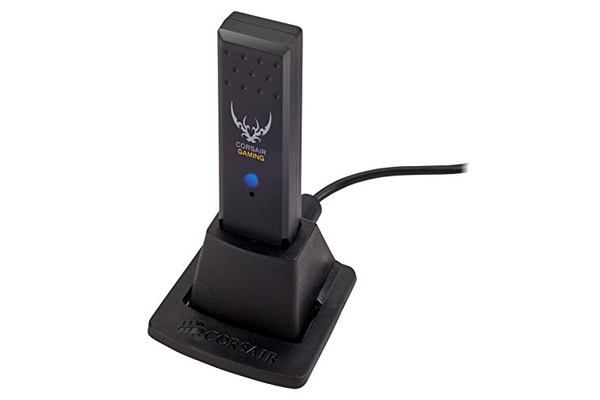
Overall, the whole setup looks rather dignified, especially since gaming peripherals often have a penchant for over-the-top or gaudy designs. The capacious size is the H2100's only major drawback, and even that isn't much of a problem if you plan to keep it in one place.
Comfort
The H2100's huge earcups and prodigious padding pay off. I was able to wear the headset for hours on end without any kind of discomfort. The headband conforms to just about any head shape, and helped me work around my glasses and big hair. While the device is a little bit heavy, it didn't weigh me down too much.
My only issue with the H2100 is that the earcups never sat properly over the bottom of my ears. Not only did this feel a little strange, but it also let some sound escape. This was slightly problematic when playing games that take advantage of surround sound (like multiplayer shooters).
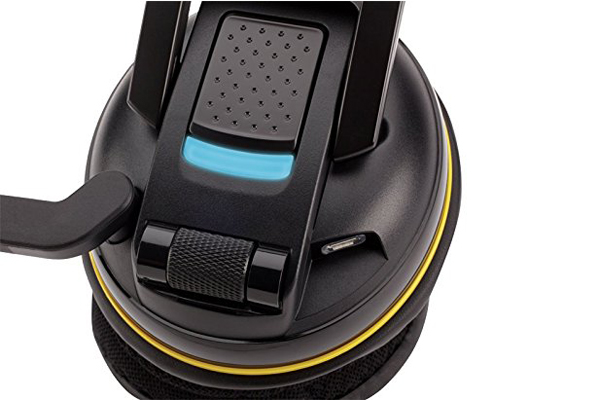
I double-checked with a co-worker who told me that the headphones actually felt a little tight around the bottom of his ears and looser at the top. It seems that head shape factors in a lot, but one way or another, the earcups won't offer a perfect fit.
Wireless
The H2100's sound quality is excellent, and it suffers absolutely no ill effects from using a wireless connection. The common perception of persistent lag and inconsistent signals in wireless gaming peripherals is, in general, unfounded; for the H2100, it has no basis in reality whatsoever.
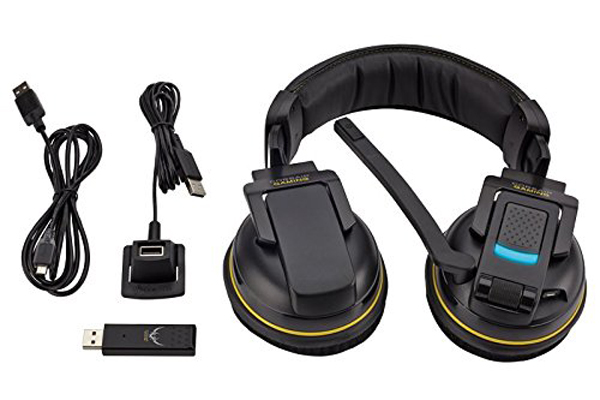
The H2100 promises up to 40 feet of crystal-clear audio in real-time, and I tested this out firsthand. The Tom's Guide office actually has a straight 40-foot hallway in front of our gaming test computer, and I was able to walk all the way to the end without losing a single second of Scott Bradlee's delightfully anachronistic cover of "Timber." A volume control right on the left earpiece was very handy.
Our office is positively chockablock with wireless signals coming from every direction, which makes the H2100's wireless capabilities all the more impressive. If you have been avoiding wireless headsets because of perceived issues with lag and clarity, the H2100 should assuage your concerns. Just be aware that the device can be a little prissy about connecting to the access point; you may need to try two or three times before you're good to go.
Gaming Performance
The best part about the H2100 is the way it sounds in-game. I tested it with Titanfall to see how it would stand up to a heated multiplayer environment and Assassin's Creed Unity to test its capacity for filmic single-player adventures.
I turned on the optional 7.1 surround sound for Titanfall, and found the results impressive. I could tell where every nearby attack came from, as pilots, mechs and weapons all came to life around me. I probably could have closed my eyes and still had a pretty fair idea of my surroundings.
Assassin's Creed Unity sounded a little flatter, but still pleasing overall. The shouts and chants of early modern Parisians were all audible, as were the impact of an Assassin diving into a bale of hay and quiet footfalls while sprinting across the roof of Notre Dame.
The microphone worked well, too. I tested it with a co-worker over Skype, and she said that my voice was consistently clear, even in the presence of a lot of background noise. The only drawback is that the software has very few mic options, so if you need anything beyond volume control, you're out of luck.
Software
The reason why the games sounded so good on the H2100 is largely due to Corsair's software. While the Corsair Gaming Headset Control Panel is hardly a match for cleaner, unified programs like the Razer Synapse 2.0, Logitech Gaming Software or SteelSeries Engine 3, it gets one thing incredibly right: gaming presets.

Unlike most gaming headset software, which offers presets only for different music genres (or no presets at all), the Gaming Headset Control Panel offers two gaming presets: one for first-person shooters and one for massively multiplayer online games. These options actually make an enormous difference to how these genres sound, and could potentially elevate the H2100 over even a very good set of standard headphones.
The problem is that the Gaming Headset Control Panel is quite sparse otherwise, featuring only an equalizer and an option to turn surround sound on or off. Compared to software like the SteelSeries Engine 3, which lets you create multiple profiles and link them with games, or the Razer Kraken 7.1 Chroma, which offers very precise surround-sound calibration, there's not much to it.
Music Performance
The H2100 delivers much better music performance than most gaming headsets I've tried, although it's still not perfect. There's a little too much reverberation with the surround sound turned on, and it sounds very flat in plain stereo. There's also a very slight background hiss, which doesn't affect gameplay much but can be annoying when listening to music.
MORE: Best Gaming Mice
Generally, though, the H2100 is just fine for listening to tunes, especially since you can walk around the room at will. (This could be incredibly convenient if you are cooking something, folding laundry or on an audio-only Skype call.) The device has a bright soundscape that offers a lot of treble, and sounds very clear across a variety of genres.
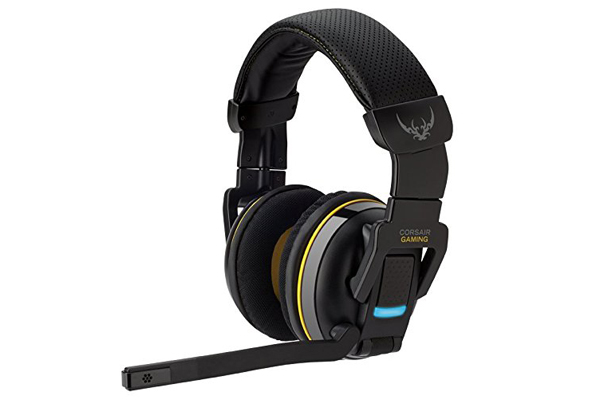
I ran through parts of Handel's "Messiah" as well as tracks from Old Crow Medicine Show and Flogging Molly on both the H2100 and my regular headphones: a set of $200 Sennheiser HD-251 IIs. While the H2100 didn't match the Sennheiser's overall quality, I was pleased to hear just how much of the same sound came through. Harmonies, bass notes and backup instruments were all very audible.
Bottom Line
A gaming headset that gets pretty much everything right is a real treat. When the headset is also wireless and retails for less than $100, it's even better. While the Corsair H2100 could have benefited from better software and slight design tweaks, it's a quality piece of hardware that's ideal for living room gaming rig setups.
Specs
Size: 9 x 3.5 x 9.5 inches
Weight: 22 oz
Connection: Wireless USB
Frequency Response: 40 Hz to 20 KHz
Volume: 132.4 dB-A
Marshall Honorof is a senior editor for Tom's Guide, overseeing the site's coverage of gaming hardware and software. He comes from a science writing background, having studied paleomammalogy, biological anthropology, and the history of science and technology. After hours, you can find him practicing taekwondo or doing deep dives on classic sci-fi.
